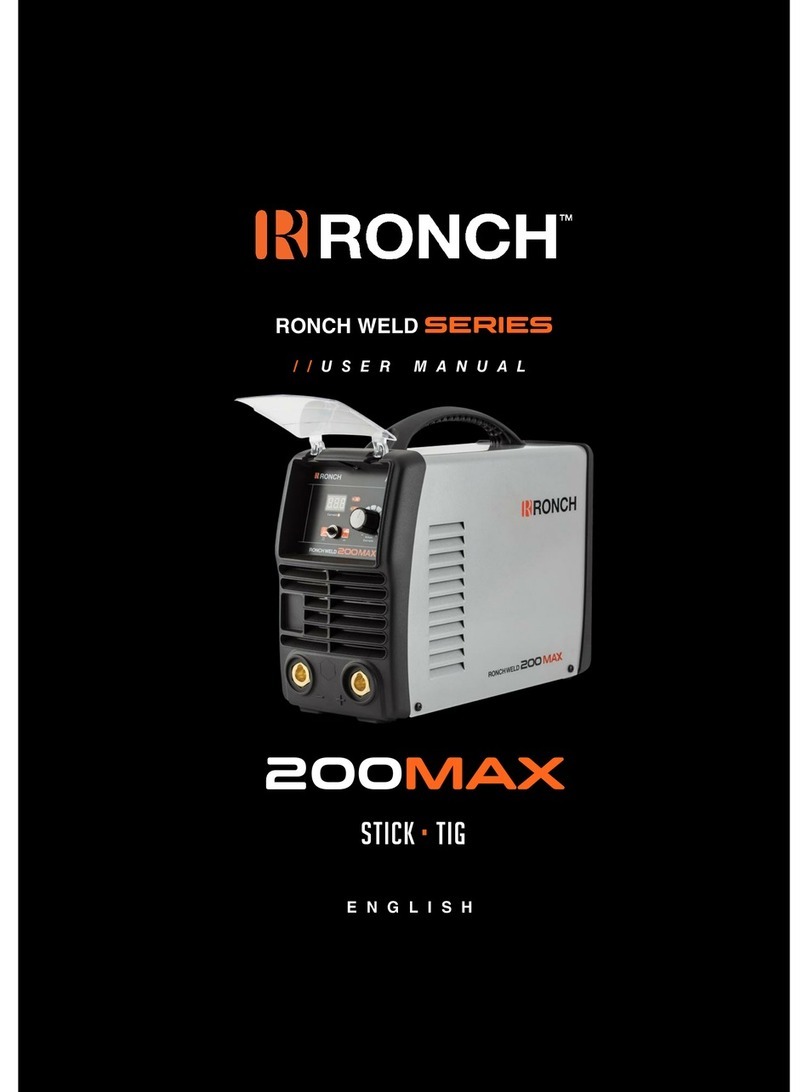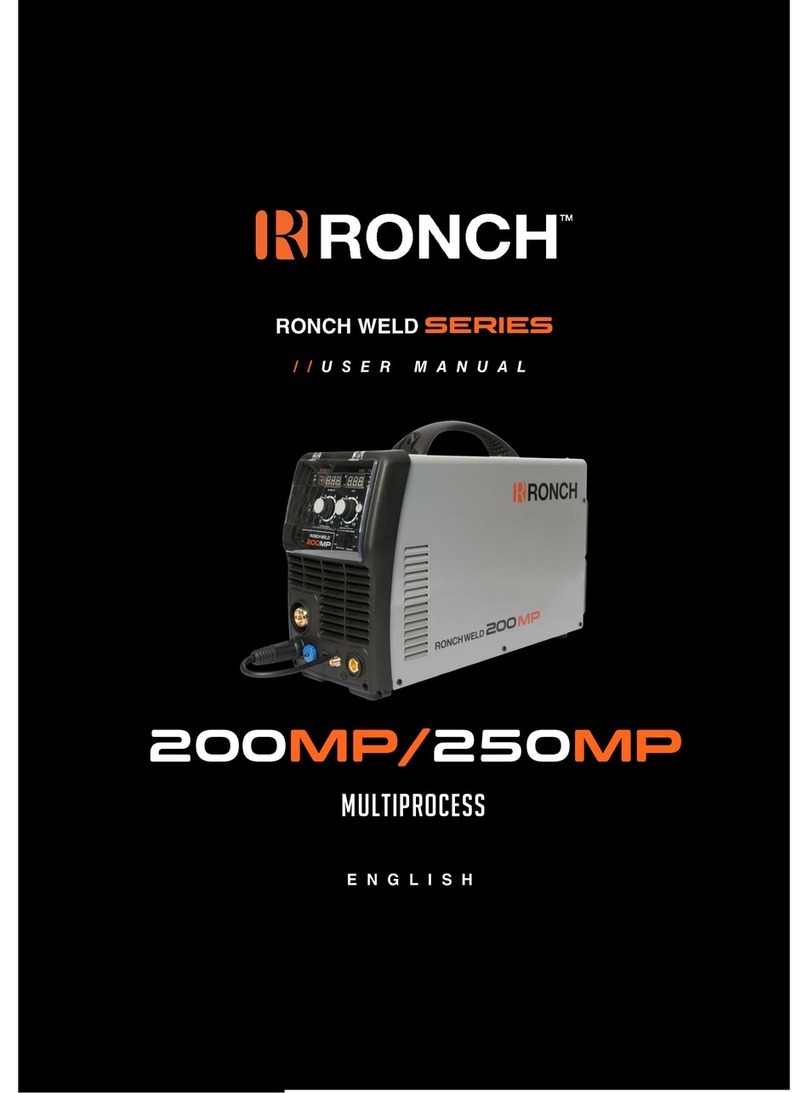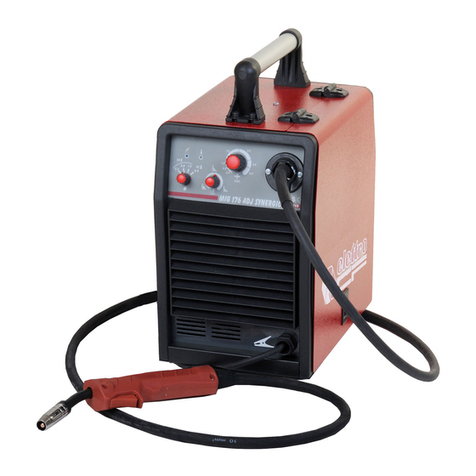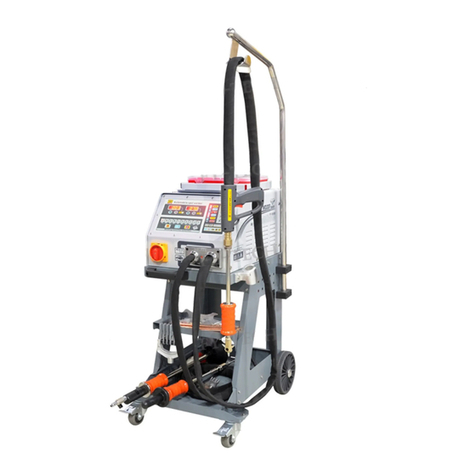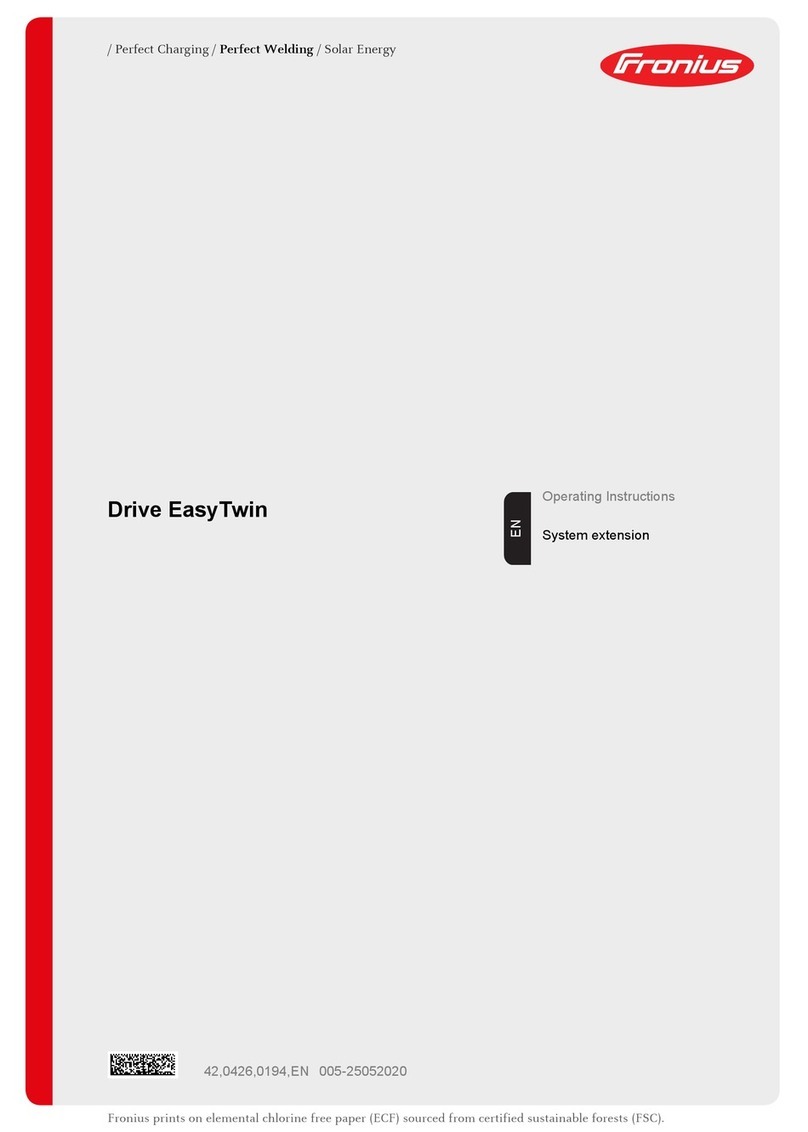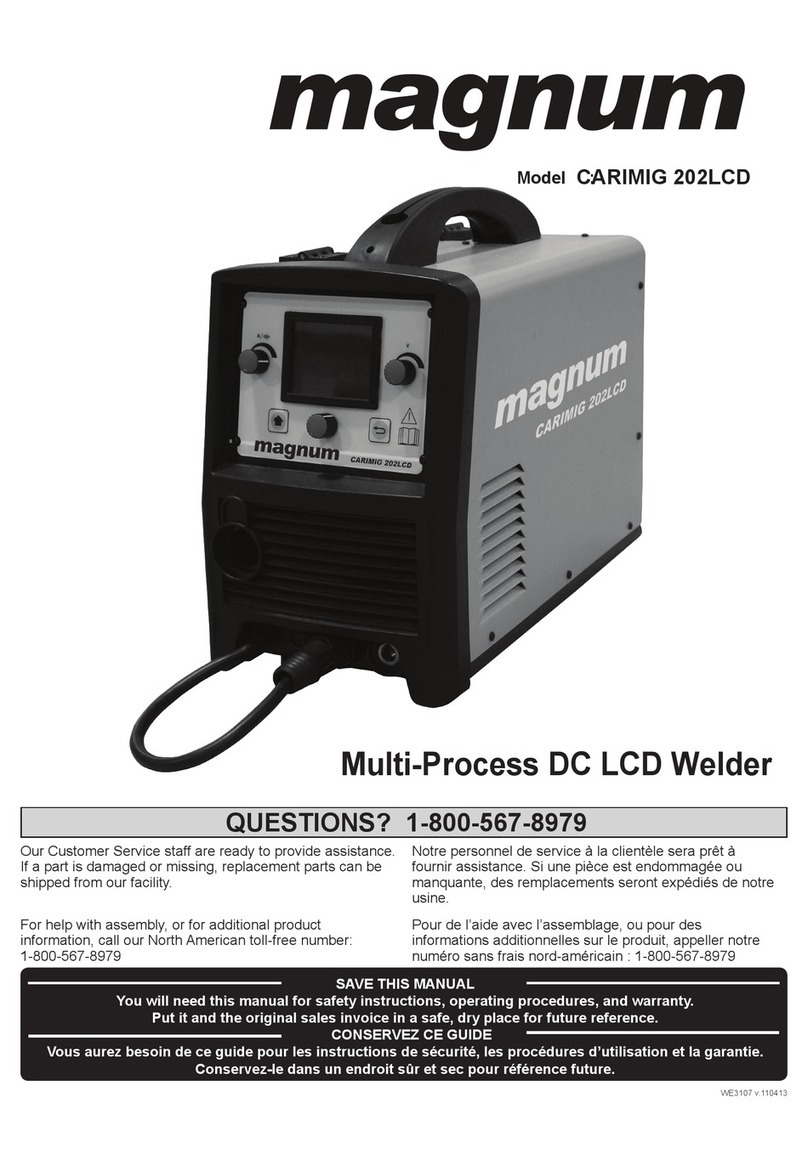Ronch Ronch Weld 200ARC DV User manual

1
SERIES
160ARC DV / 200ARC DV
STICK •TIG

2
CONTENT
1. Safety •4
1.1. Symbols Explanation •4
1.2. Machine Operating Warnings •4
1.3. EMC Device Classification •10
1.4. EMC Measure •10
1.5. Warning Label •11
2. OVERVIEW •12
2.1. Features •12
2.2. Technical Data •12
2.3. Brief Introduction •14
2.4. Duty Cycle and Over-heat •15
2.5. Working Principal •15
2.6. Volt-Ampere Characteristic •16
3. Installation & Operation •17
3.1. Layout for the Front and Rear Panel •17
3.2. Installation for MMA Welding •17
3.2.1. Setup Installation for MMA Welding •17
3.2.2. Operation for MMA Welding •19
3.2.3. MMA Welding •19
3.2.4. MMA Welding Fundamentals •21
3.2.5. MMA Welding TroubleShooting •23
3.3. Installation and Operation for TIG Welding •24
3.3.1. Set Up Installation for TIG Welding •24
3.3.2. Operation for TIG Welding •25
3.3.3. TIG Welding Fundamentals •25
3.3.4. DC TIG Welding TroubleShooting •27
3.4. Operation Environment •29
3.5. Operation Notices •29

3
4. Maintenance & Troubleshooting •30
4.1. Maintenance •30
4.2. Troubleshooting •32
4.3. List of Error Codes •34
4.4. Electrical Schematic Drawing •35

4
1. Safety
Welding and cutting equipment can be dangerous to both the operator and people in or
near the surrounding working area, if the equipment is not correctly operated. Equipment must
only be used under the strict and comprehensive observance of all relevant safety regulations.
Read and understand this instruction manual carefully before the installation and operation of this
equipment.
•1.1. Symbols Explanation
The above symbols mean warning!
Notice! Running parts, getting an electric shock or making contacts with thermal parts will cause
damage to your body and others. The underline message is as follows:
Welding is quite a safe operation after taking several necessary protection measures!
•1.2. Machine Operating warnings
The following symbols and words explanations are for some damages to your body or others,
which could happen during the welding operation. While seeing these symbols, please remind
yourself and others to be careful.
Only people who are trained professionally can install, debug, operate, maintain and repair the
welding equipment covered with this Operator’s Manual!
During the welding operation, non-concerned people should NOT be around, especially children!
After shutting off the machine power, please maintain and examine the equipment according to
§4 because of the DC voltage existing in the electrolytic capacitors at the output of the power
supply!
ELECTRIC SHOCK CAN KILL.
Touching live electrical parts can cause fatal shocks or severe burns. The electrode and work
circuit is electrically live whenever the output is on. The input power circuit and internal machine
circuits are also live when power is on. In Mig/Mag welding, the wire, drive rollers, wire feed
housing, and all metal parts touching the welding wire are electrically live. Incorrectly installed or
improperly grounded equipment is dangerous.

5
Never touch live electrical parts.
Wear dry, hole-free gloves and clothes to insulate your body.
Be sure to install the equipment correctly and ground the work or metal to be welded to a
good electrical (earth) ground according to the operation manual.
The electrode and work (or ground) circuits are electrically “hot” when the machine is ON.
Do not touch these “hot” parts with your bare skin or wet clothing. Wear dry, hole-free
gloves to insulate hands.
In semiautomatic or automatic wire welding, the electrode, electrode reel, welding head,
nozzle or semiautomatic welding gun are also electrically “hot”.
Insulate yourself from work and ground using dry insulation. Make certain the insulation is
large enough to cover your full area of physical contact with work and ground.
Be Careful when using the equipment in small places, falling-off and wet circumstance.
Always be sure the work cable makes a good electrical connection with the metal being
welded. The connection should be as close as possible to the area being welded.
Maintain the electrode holder, work clamp, welding cable and welding machine in good,
safe operating condition. Replace damaged insulation.
Never dip the electrode in water for cooling.
Never simultaneously touch electrically “hot” parts of electrode holders connected to two
welders because voltage between the two can be the total of the open circuit voltage of
both welders.
When working above the floor level, use a safety belt to protect yourself from a fall should
you get an electric shock!
FUMES AND GASES CAN BE DANGEROUS.
Smoke and gas generated whilst welding or cutting can be harmful to people’s health. Welding
produces fumes and gases. Breathing these fumes and gases can be hazardous to your health.
Do not breathe the smoke and gas generated whilst welding or cutting, keep your head
out of the fumes. Use enough ventilation and/or exhaust at the arc to keep fumes and
gases away from the breathing zone. When welding with electrodes which require special
ventilation such as stainless or hard facing or on lead or cadmium plated steel and other
metals or coatings which produce highly toxic fumes, keep exposure as low as possible and
below the Threshold Limit Values using local exhaust or mechanical ventilation. In
confined spaces or in some circumstances, outdoors, a respirator may be required.
Additional precautions are also required when welding on galvanized steel.
Do not weld in locations near chlorinated hydrocarbon vapors coming from degreasing,
cleaning or spraying operations. The heat and rays of the arc can react with solvent vapors
to form phosgene, a highly toxic gas, and other irritating products.
Shielded gases used for arc welding can displace air and cause injury or death. Always use
enough ventilation, especially in confined areas, to insure breathing air is safe.

6
Read and understand the manufacturer’s instructions for this equipment and the
consumables to be used, including the material safety data sheet and follow your
employer’s safety practices.
ARC RAYS: Harmful to people’s eyes and skin.
Arc rays from the welding process produce intense visible and invisible ultraviolet and infrared
rays that can burn eyes and skin.
Use a shield with the proper filter and cover plates to protect your eyes from sparks and
the rays of the arc when welding or observing open arc welding.
Use suitable clothing made from durable flame-resistant material to protect your skin and
that of your coworkers from the arc rays.
Protect other nearby personnel with suitable, non-flammable screening and /or warn
them not to watch the arc nor expose themselves to the arc rays or to hot spatter or
metal.
SELF-PROTECTION
Keep all equipment safety guards, covers and devices in position and in good repair. Keep
hands, hair, clothing and tools away from V-belts, gears, fans and all other moving parts
when starting, operating or repairing equipment.
Do not put your hands near the engine fan. Do not attempt to override the governor or
idler by pushing on the throttle control rods while the engine is running.
DO NOT add any fuel near an open-flame welding arc or when the engine is running. Stop the
engine and allow it to cool before refueling to prevent spilled fuel from vaporizing on contact with
hot engine parts and igniting. Do not spill fuel when filling tank. If fuel is spilled, wipe it up and do
not start engine until fumes have been eliminated.

7
WELDING SPARKS can cause fire or explosion.
Welding on closed containers, such as tanks, drums, or pipes, can cause them to explode. Flying
sparks from the welding arc, hot work piece, and hot equipment can cause fires and burns.
Accidental contact of electrode to metal objects can cause sparks, explosion, overheating, or fire.
Check and be sure the area is safe before doing any welding.
Remove fire hazards material from the welding area. If this is not possible, cover them to
prevent the welding sparks from starting a fire. Remember that welding sparks and hot
materials from welding can easily go through small cracks and openings to adjacent areas.
Avoid welding near hydraulic lines. Have a fire extinguisher readily available.
Where compressed gases are to be used at the job site, special precautions should be used
to prevent hazardous situation.
When not welding, make certain no part of the electrode circuit is touching the work or
ground. Accidental contact can cause overheating and create a fire hazard.
Do not heat, cut or weld tanks, drums or containers until the proper steps have been
taken to insure that such procedures will not cause flammable or toxic vapors from
substances inside. They can cause an explosion even though they have been “cleaned”.
Vent hollow castings or containers before heating, cutting or welding. They may explode.
Sparks and spatter are thrown from the welding arc. Wear oil free protective garments
such as leather gloves, heavy shirt, cuff less trousers, high shoes and a cap over your hair.
Wear earplugs when welding out of position or in confined places. Always wear safety
glasses with side shields when in a welding area.
Connect the work cable to the work as close to the welding area as practical. Work cables
connected to the building framework or other locations away from the welding area
increase the possibility of the welding current passing through lifting chains, crane cables
or other alternate circuits. This can create fire hazards or overheat lifting chains or cables
until they fail.
Rotating parts may be dangerous.
Use only compressed gas cylinders containing the correct shielding gas for the process
used and properly operating regulators designed for the gas and pressure used. All hoses,
fittings, etc. should be suitable for the application and maintained in good condition.
Always keep cylinders in an upright position securely chained to an undercarriage or fixed
support.
Cylinders should be located:
-Away from areas where they may be struck or subjected to physical damage.
-At a safe distance from arc welding or cutting operations and any other source of heat,
sparks, or flame.

8
Never allow the electrode, electrode holder or any other electrically “hot” parts to touch a
gas cylinder.
Keep your head and face away from the cylinder valve outlet when opening the cylinder
valve.
Valve protection caps should always be in place and hand tight except when the cylinder is
in use or connected for use.
Gas Cylinders.
Shielding gas cylinders contain gas under high pressure. If damaged, a cylinder can explode.
Because gas cylinders are normally part of the welding process, be sure to treat them carefully.
CYLINDERS can explode if damaged.
Protect gas cylinders from excessive heat, mechanical shocks, physical damage, slag, open
flames, sparks, and arcs.
Insure cylinders are held secure and upright to prevent tipping or falling over.
Never allow the welding electrode or earth clamp to touch the gas cylinder, do not drape
welding cables over the cylinder.
Never weld on a pressurised gas cylinder, it will explode and kill you.
Open the cylinder valve slowly and turn your face away from the cylinder outlet valve and
gas regulator.
Gas build up.
The build up of gas can causes a toxic environment, deplete the oxygen content in the air resulting
in death or injury. Many gases use in welding are invisible and odourless.
Shut off shielding gas supply when not in use.
Always ventilate confine spaces or use approved air-supplied respirator.
Electric and Magnetic Fields.
Electric current flowing through any conductor causes localized Electric and Magnetic Fields (EMF).
The discussion on the effect of EMF is ongoing in the entire world. Up to now, no material

9
evidences show that EMF may have effects on health. However, the research on the effect of EMF
is still ongoing. Before any conclusion, we should minimize exposure to EMF as few as possible.
In order to minimize EMF, we should use the following procedures:
Route the electrode and work cables together –Secure them with tape when possible.
All cables should be put away and far from the operator.
Never coil the power cable around your body.
Make sure welding machine and power cable to be far away from the operator as far as
possible according to the actual circumstance.
Connect the work cable to the workpiece as close as possible to the area being welded.
The people with heart-pacemaker should be away from the welding area.
Noise can damage hearing.
Noise from some processes or equipment can damage hearing. You must protect your ears from
loud noise to prevent permanent loss of hearing.
To protect your hearing from loud noise, wear protective ear plugs and/or ear muffs.
Protect others in the workplace.
Noise levels should be measured to be sure the decibels (sound) do not exceed safe levels.
Hot parts.
Items being welded generate and hold high heat and can cause severe burns. Do not touch hot
parts with bare hands. Allow a cooling period before working on the welding gun. Use insulated
welding gloves and clothing to handle hot parts and prevent burns.
•1.3. EMC device classification
Radiation Class A Device.
Only can be used in the industrial area
If it is used in other area, it may cause connection and radiation problems of circuit.

10
Radiation Class B device.
It can meet the radiation requirements of residential area and industrial area. It also can
be used in residential area which power is supplied by public low voltage circuit.
EMC device can be classified by power nameplate or technical data.
Hi-zone welding machines belong to Class A.
•1.4. EMC measure
In the special situation, The specified area may be affected, the standard of radiation limit value
has been complied with (eg: The device, which is easy effected by electromagnetism, is used at the
installation location, or there is radio or TV near the installation location). In this condition, the
operator should adopt some appropriate measures to remove interference.
Accoring to the domestic and international standards, the ambient devices’ electromagnetism
situation and anti-interference ability must be checked:
Safety device
Power line, Signal transmission line and Date transmission line
Date processing equipment and telecommunication equipment
Inspection and calibration device
The effective measures avoid the problem of EMC:
a) Power source
Even though the power source connection meet rules, we still need to take additional
measure to remove the electromagnetic interference. (eg: Use the right power filter.)
b) The welding line
Try to shorten the length of cable
Put the cable together
Be Far away from other cable
c) Equipotential connection
d) Ground connection of work-piece
When necessary, use appropriate capacitance to connect the ground.
e) Shielding, when necessary
Shield the ambient devices
Shield the whole welding machine

11
•1.5. Warning label
The device with a warning label. Do not remove, destroy or cover this label. These
warnings are intended to avoid incorrect device operations that could result in serious personal
injury or property damage.

12
2. Overview
•2.1. Features
Multi voltage input
Works with 110V and 220V.
Tig Mode
Capable of welding with Lift Tig Mode.
Extra functions
"Hot Start", "Arc Force" and "Anti-sticking"
built in.
"Hot Start" function for easier arc striking;
"Arc Force" to prevent electrode sticking to
the work- piece; Smoother welding and deeper
penetration;
"Anti-sticking" device to prevent overload and
ease the electrode removal from the
workpiece.
Protections
Fully protected against over-voltage, under-
voltage and over-heat.
Digital display
Variable amperage control with digital meter,
for a simultaneous welding current display.
Weight
Generator friendly
Designed to work with diesel generators and
to avoid failures due to its voltage spikes.

13
•2.2. Technical Data
Models
Parameters
ARC 125 LT DV
ARC 140 LT DV
Power Supply Voltage (V)
1-110V±10%
1-220V±10%
1-110V±10%
1-220V±10%
Frequency(HZ)
50/60
MMA
TIG
MMA
TIG
MMA
TIG
MMA
TIG
Rated input current (A)
51
33.5
30
20
51
33.5
28
20
Rated input power (KW)
3.8
2.4
4.2
2.8
3.8
2.4
4.1
2.8
Duty cycle (40°C 10 min.)
15% 120A
40% 125A
15% 120A
30% 140A
60% 60A
60% 105A
60% 60A
60% 100A
100% 50A
100% 80A
100% 50A
100% 80A
Welding Current Range (A)
10-120
10-125
10-120
10-140
No Load Voltage (V)
88
24
88
24
Efficiency (%)
≥80%
Power Factor
0.65
Insulation class
H
Protection class
IP23
Cooling
AF
Net Weight (kg)
4.0
Dimensions (mm)
290*135*280
Electrode Diameter
ø1.6~ø4.0
Electrode Type
6013, 7018, etc.
Note: The above parameters are subject to change with future machine improvement!
Models
Parameters
ARC 160 LT DV
ARC 180 LT DV
Power Supply Voltage (V)
1-110V±10%
1-220V±10%
1-110V±10%
1-220V±10%
Frequency (HZ)
50/60
MMA
TIG
MMA
TIG
MMA
TIG
MMA
TIG
Rated input current (A)
51
33.5
34
23
51
33.5
40
28
Rated input power (KW)
3.8
2.4
4.9
3.2
3.8
2.4
5.8
3.9
Duty cycle (40°C 10 min.)
15% 120A
40% 160A
15% 120A
25% 180A
60% 60A
60% 135A
60% 60A
60% 120A
100% 50A
100% 105A
100% 50A
100% 90A
Welding Current Range (A)
10-120
10-160
10-120
10-180
No Load Voltage (V)
88
24
88
24
Efficiency (%)
≥80%
Power Factor
0.65
Insulation class
H
Protection class
IP23
Cooling
AF
Net Weight (Kg)
4.0

14
Dimensions (mm)
290*135*280
Electrode Diameter
ø1.6~ ø5.0
Electrode Type
6013, 7018, etc.
Note: The above parameters are subject to change with future machine improvement!
Models
Parameters
RONCHWELD 200 ARC DV
ARC 220 LT DV
Power Supply Voltage (V)
1-110V±10%
1-220V±10%
1-110V±10%
1-220V±10%
Frequency (HZ)
50/60
MMA
TIG
MMA
TIG
MMA
TIG
MMA
TIG
Rated input current (A)
51
33.5
45
31
51
33.5
51
37
Rated input power (KW)
3.8
2.4
6.6
4.5
3.8
2.4
7.2
5.2
Duty cycle (40℃10 min)
30% 120A
30% 200A
15% 120A
25% 180A
60% 85A
60% 145A
60% 60A
60% 120A
100% 70A
100% 110A
100% 50A
100% 90A
Welding Current Range (A)
10-120
10-200
10-120
10-220
No Load Voltage (V)
88
24
88
24
Efficiency (%)
≥80%
Power Factor
0.65
Insulation class
H
Protection class
IP23
Cooling
AF
Net Weight (kg)
4.0
Dimensions (mm)
290*135*280
Electrode Diameter
ø1.6~ø5.0
Electrode Type
6013, 7018, etc.
Note: The above parameters are subject to change with future machine improvement!
•2.3. Brief Introduction
ARC series of welding machines adopt the latest Pulse Width Modulation (PWM)
technology and the Insulated Gate Bipolar Transistor (IGBT) power modules. It uses switching
frequencies in the 20KHz-50KHz ranges so as to replace the traditional line-frequency transformer
type welding machines. Thus, machines are characterized with portability, small size, lightweight,
low energy consumption and noise, etc.
ARC series of welding machines has excellent performance: constant current output makes
welding arc more stable; fast dynamic response speed reduces the impact from the arc length
fluctuation to the current; accurate stepless current adjustment and pre-setting function. There
are also some automatic protection functions for under voltage, over current, over heat, etc.
inside the welder, when the problems listed before occurred, the alarm light on the front panel is

15
on and at the same time the output current will be cut off. It can self-protect, prolong the usefull
life, greatly improved the reliability and practicality of the welding machine.
ARC series of welding machines can also realize TIG operation. While MMA operation, if
the electrode touches workpiece over two seconds, the welding current will drop to the minimum
current automatically to protect the electrode. While TIG operation, the minimum current will be
outputted firstly until the arc is ignited by lifting method, the output current will rise to the pre-set
value, which can protect the electrode.
ARC series of welding machines is widely used in Petroleum, chemical, mechanical,
shipbuilding, architecture, boiler, pressure container, military industry and Maintenance work, etc.
This machine has high duty cycle even in the 40℃, which can keep the continuous operation. The
frame is Stability of the machine, which can keep working under high temperature and corrosion
environment.
MMA —Manual Metal Arc welding;
PWM —Pulse-Width Modulation;
IGBT —Insulation Gate Bipolar Transistor;
TIG —Tungsten Inert Gas welding.
•2.4. Duty cycle and Over-heat
The letter “X” stands for Duty Cycle,
which is defined as the portion of the time a
welding machine can weld continuously with
it’s rated output current within a certain
time cycle (10 minutes).
The relation between the duty cycle
“X” and the output welding current “I” is
shown as the right figure.
If the welding machine is
overheating, the IGBT over-heat protection
sensing will send a signal to the welding
machine control unit to cut the output
welding current OFF and light the over-heat pilot lamp on the front panel. In that case, the
machine should not be welding for 10-15 minutes to cool down with the fanrunning. When
operating the machine again, the welding output current or the duty cycle should be reduced.
Relation of welding current
and duty cycle for ARC 125 LT DV

16
•2.5. Working Principle
The working principle of ARC series of welding machines is shown in the following figure.
Single-phase 110V/220V line frequency AC is rectified into DC, then is converted to medium
frequency AC by inverter device (IGBT), after reducing voltage by medium transformer (the main
transformer) and rectified by medium frequency rectifier (fast recovery diode), and is outputted
by inductance filtering. The circuit adopts current feedback control technology to insure current
output stability. Meanwhile, the welding current parameters can be adjusted continuously and
steplessly to meet with the requirements of welding craft.
•2.6. Volt-Ampere Characteristic
ARC series of welding machines has excellent volt-ampere characteristic. Referring to the
following graph. In MMA welding, the relation between the rated loading voltage U2and welding
current I2 is as follows:
When I2≤600ª, U2=20+0.04 I2 (V); When I2>600ª, U2=44(V).
Rectify Inverter Medium
frequency
transformer
Medium
frequency
rectify Hall device
Current positive-
feedback control
Three-phase, AC DC AC DC
380V,50Hz
AC DC
66
44
20
0600 I2(A)
U2(V)
Working
point
Volt-ampere characteristic
The relation of the rated loading
voltage&welding current
Single-phase, AC
110V/220V
50/60Hz

17
3. Installation & Operation
•3.1. Layout for the front and rear panel
(1) “+” Output terminal.
(2) “-” Output terminal.
(3) Conversion switch:
Choose (left) LIFT TIG;
choose (right) MMA.
(4) Current digital display.
(5) Power light: Power
indicator, power on
light on.
(6) Alarm light: Alarm
indicator, lights that
occurred over voltage,
over current, or
overheating inside the
machine, is protected.
(7) Welding current
adjustment knob: Turn
this knob to adjust the
output current size.
(8) Power switch: control
power through and
break.
(9) Power Access client: access to cable.
(10)Fan: Help plant cooling.
•3.2. Installation for MMA Welding
•3.2.1. Set up installation for MMA Welding
Connection of Output Cables
Two sockets are available on this welding machine. For MMA welding the electrode holder is
shown be connected to the positive socket, while the earth lead (work piece) is connected to the
negative socket, this is known as DCEP. However various electrodes require a different polarity for
optimum results and careful attention should be paid to the polarity, refer to the electrode
manufacturers information for the correct polarity.
DCEP: Electrode connected to “+” output socket.
DCEN: Electrode connected to “-“output socket.

18
(1) Connect the earth lead to “-“,tighten clockwise;
(2) Connect the earth clamp to the work piece. Contact with the work piece must be firm
contact with clean, bare metal, with no corrosion, paint or scale at the contact point.
(3) Connect the electrode lead to “+”,tighten clockwise;
(4) Each machine is equipped with a power cable should be based on the input voltage
welding power cable connected to the appropriate position, not to pick the wrong voltage;
(5) With the corresponding input power supply terminal or socket good contact and prevent
oxidation;
(6) With a multi meter measure the input voltage is within the fluctuation range;
(7) The power ground is well grounded.
•3.2.2. Operation for MMA Welding
(1) According to the above method to install is correct, turn the power switch, so that the
power switch is “ON” position, then the power indicator light, the fan comes on, the
device work properly.
(2) Select the MMA function with the LIFT TIG/MMA selector switch.

19
(3) Set the welding current relevant to the electrode type and size being used as
recommended by the electrode manufacturer.
(4) Place the electrode into the electrode holder and clamp tight.
(5) Strike the electrode against the work piece to create and arc and hold the electrode
steady to maintain the arc.
(6) Commence welding. If necessary, readjust the Weld Current control to obtain the welding
condition required.
(7) After completion of welding the Power Source should be left turned ON for 2 to 3 minutes.
This allows the fan to run and cool the internal components.
(8) Switch the ON/OFF Switch (located on the rear panel) to the OFF position.
NOTE:
Note the polarity of wiring, the general DC welding wire in two ways. Selected according
to the technical requirements of welding the appropriate connection, if you choose
incorrectly will result in arc instability and spatter large adhesion and other phenomena,
such cases can be quickly reversed to joints.
If the work piece distance from the welding machine, the second line (electrode holder
and ground) is longer, so choose the appropriate conductor cross-sectional area should be
larger to reduce cable voltage drop.
•3.2.3. MMA Welding
One of the most common types of arc welding is manual metal arc welding (MMA) or stick
welding. An electric current is used to strike an arc between the base material and a consumable
electrode rod or ‘stick’. The electrode rod is made of a material that is compatible with the base
material being welded and is covered with a flux that gives off gaseous vapours that serve as a
shielding gas and providing a layer of slag, both of which protect the weld area from atmospheric
contamination. The electrode core itself acts as filler material the residue from the flux that forms
slag covering over the weld metal must be chipped away after welding.

20
The arc is initiated by momentarily
touching the electrode to the base
metal.
The heat of the arc melts the surface of
the base metal to form a molten pool at
the end of the electrode.
The melted electrode metal is
transferred across the arc into the
molten pool and becomes the deposited
weld metal.
The deposit is covered and protected by
a slag which comes from the electrode
coating.
The arc and the immediate area are enveloped by an atmosphere of protective gas.
Manual metal arc (stick) electrodes have a solid
metal wire core and a flux coating. These electrodes
are identified by the wire diameter and by a series
of letters and numbers. The letters and numbers
identify the metal alloy and the intended use of the
electrode.
The Metal Wire Core works as conductor of the
current that maintains the arc. The core wire melts
and is deposited into the welding pool.
The covering on a shielded metal arc
welding electrode is called Flux.
The flux on the electrode performs many diferent
functions.
These include:
producing a protective gas around the
weld area
providing fluxing elements and deoxidizer
creating a protective slag coating over the
weld as it cools
establishing arc characteristics
adding alloying elements.
Covered electrodes serve many purposes in addition to filler metal tothe molten pool. These
additional functions are provided mainly by the covering on the electrode.
This manual suits for next models
8
Table of contents
Other Ronch Welding System manuals
Popular Welding System manuals by other brands
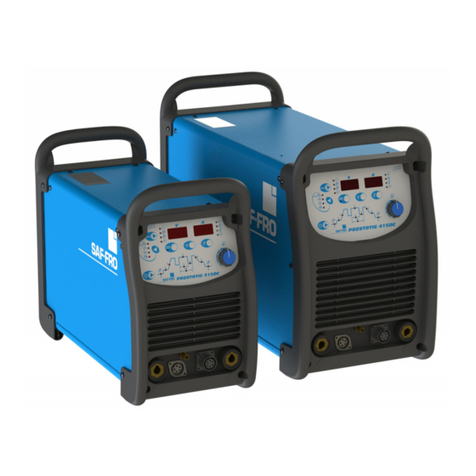
Saf-Fro
Saf-Fro PRESTOTIG 315DC Operator's manual
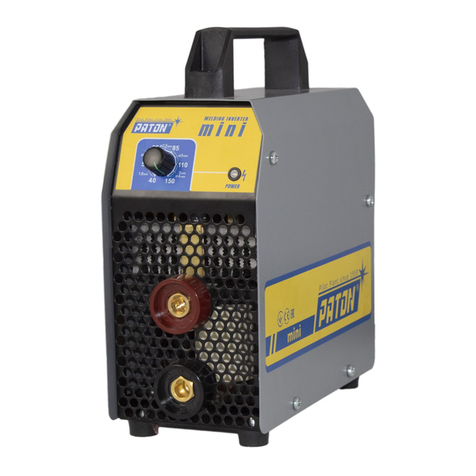
Paton
Paton VDI 150 MINI manual

stayer
stayer Gama HILO MIG160Multi operating instructions

Miller
Miller Big Blue 300 PRO Series owner's manual

Miller Electric
Miller Electric OM-1500-4 owner's manual
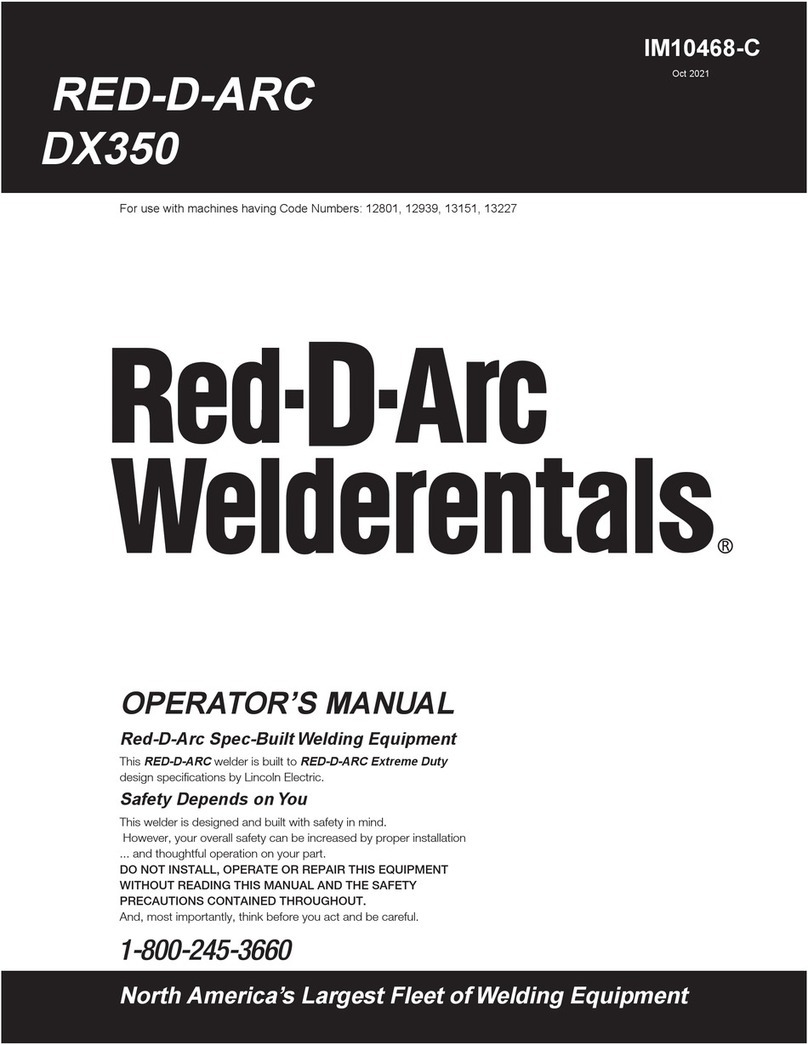
Red-D-Arc Welderentals
Red-D-Arc Welderentals DX350 Operator's manual
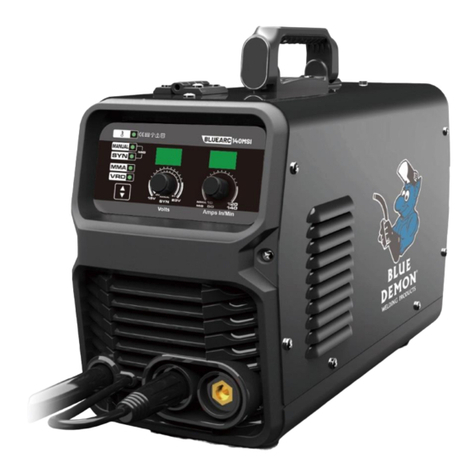
Blue Demon
Blue Demon IGBT Series owner's manual
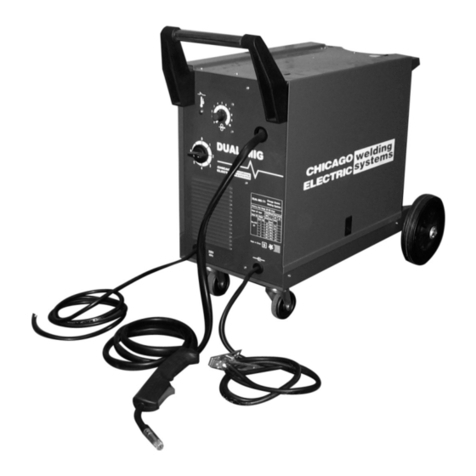
Chicago Electric
Chicago Electric 93793 Set up and operating instructions
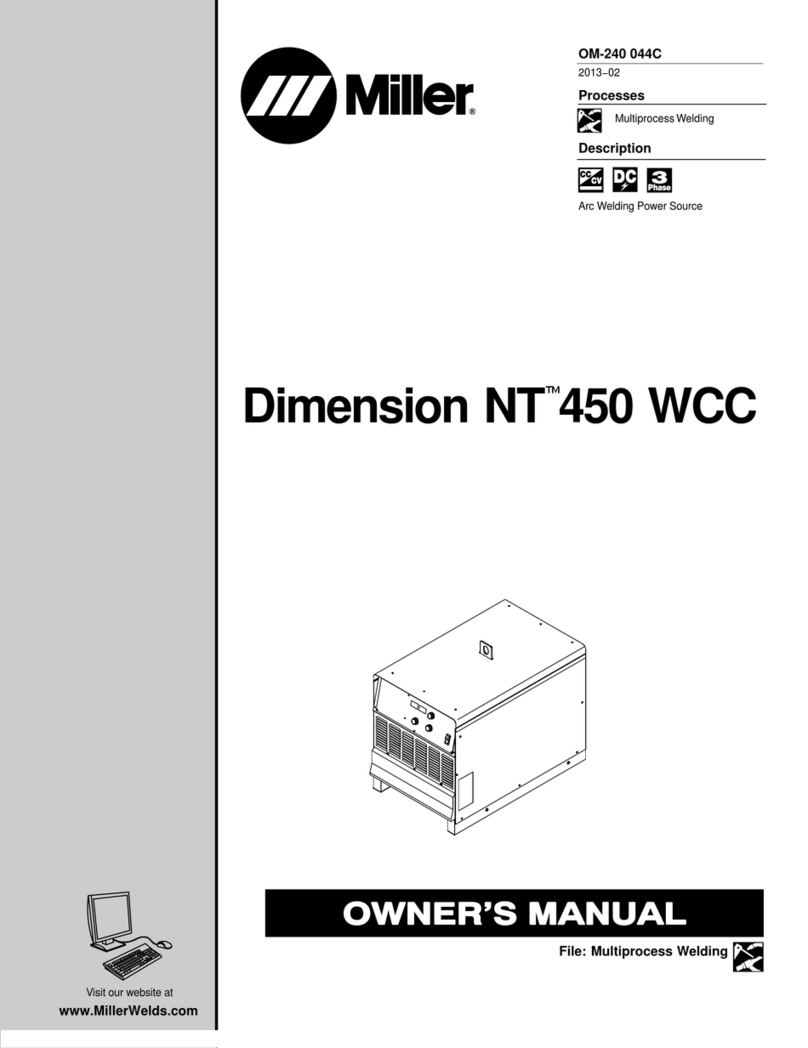
Miller
Miller DIMENSION NT 450 WCC owner's manual

BINZEL-ABICOR
BINZEL-ABICOR ABIPLAS WELD 100 POWDER W operating instructions
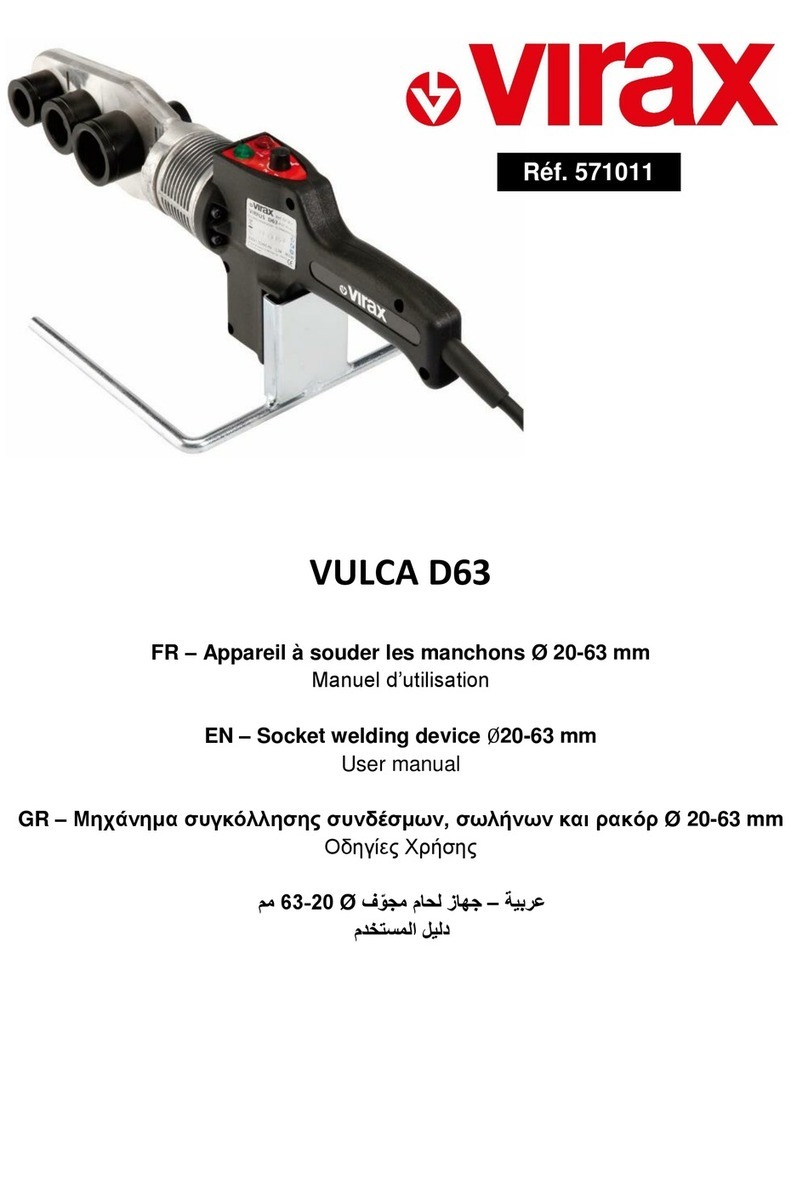
Virax
Virax VULCA D63 user manual
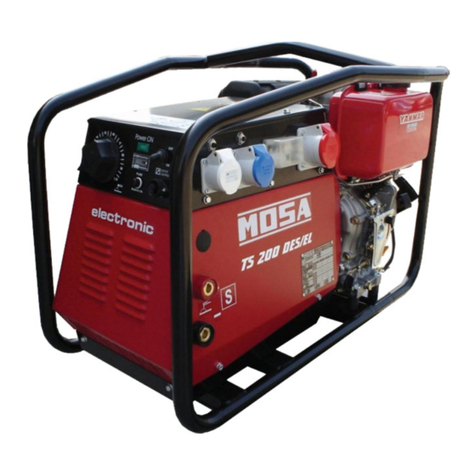
Mosa
Mosa TS 200 KDES/EL Use and maintenance manual
